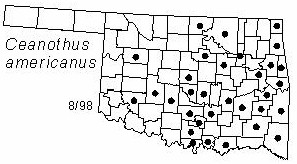Shrub to 1 m (3 ft) in height. Twigs dark gray-green, densely pubescent. Leaves alternate, simple; ovate to obovate, 5-10 cm (2-4 in) long and 2.5-6 cm (1-2.3 in) wide; glabrous above, scattered gray hairs beneath; upper surface green, cordate or rounded at base; acute to acuminate at apex, margins serrate, 3-ribbed; petiole about 1 cm (0.5 in) long. Inflorescence an axillary panicle of several flowers; calyx campanulate, 5-lobed, incurved; petals 5, hooded, usually notched; ovary 3-lobed, style short and 3-cleft; stamens 4-5; flowers appear in May. Fruit a drupe, about 6 mm (0.25 in) in diameter, obovoid; seeds 3; fruits mature in July.
Distribution: Oklahoma and Texas, east to Florida, north to Quebec, west to Manitoba, south to Arkansas. Common.
Habitat: shallow rocky soil in prairies and roadsides.
Comments: Ceanothus is a name given by Theophrastus; americanus refers to North America.
Food use: leaves were used as a tea substitute during the Revolutionary War.
Medicinal uses: roots are an astringent. Contains ceanothic acid and three alkaloids, one known as ceanothine. Native American used New Jersey tea to treat snake bite and gastrointestinal discomfort. New Jersey tea was once used to treat syphilis.
NWI status: none
Distribution in Oklahoma: 
BACK
NEXT
RETURN TO INDEX
Last update: 9/9/99
 Go to Oklahoma Biological Survey Home Page
Go to Oklahoma Biological Survey Home Page
 Disclaimer
Disclaimer